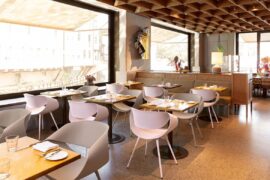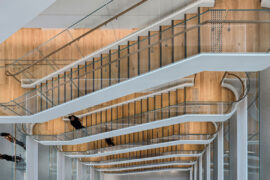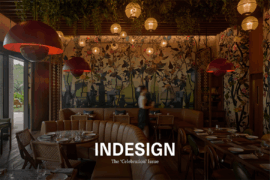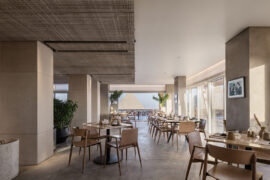An interest in algorithms led Cologne-based Alexander Lorenz to a collaboration with furniture manufacturer titan Herman Miller to produce a furniture screening system for the office. Here’s the story of how Kivo – one of Lorenz’s very first design projects – came to be.

October 23rd, 2014
The partnership between Alexander Lorenz and Herman Miller appears to be a most unlikely one. Lorenz, who hails from Cologne, Germany, has a background in business administration, and a keen interest in natural science and algorithms. And the only other product he has designed and sold, aside from the now much talked about Kivo office partition system for Herman Miller’s Living Office, is a golf club, done in partnership with a friend while still in school.
But one thing that the young and enterprising Lorenz has – in abundance – is a passion to create. The journey to the final product that is now Kivo was “almost random” Lorenz candidly shares, and began when he went searching for a method to align identical triangles. At first, it was purely an explorative exercise, he says, though it eventually led him to “want to create a physical product”.
With his initial idea being an object for the home, Lorenz started taking his product to a few select customers in a bid to gauge market response and to fine-tune the design. Interestingly, most were interested in them for retail and temporary spaces. Then, sufficiently confident with his creation, he decided to approach Herman Miller with the project.
“I wanted to have a strong partner who would be able to distribute the product worldwide. I felt Herman Miller was the perfect fit… I would say the product perfectly fits with their DNA, and they have also worked with equilateral triangles. There was no excuse not to contact them.”
Kivo, which launched to much fanfare at Singapore Indesign a few weeks ago, is a screening device made of only one type of triangular tile, and users can easily move the modules around to suit their own needs. It’s made of less than five components, but because it is based on a unique algorithmic formula, the permutations are as infinite as the designer’s own imagination. Not only do the felt covers come in a wide range of colours and textures, but Herman Miller also offers additional customisation options for clients looking for something more bespoke.
“The result looks pretty simple, but the manufacturing process is quite complex,” says Lorenz. “Some parts were hard to manufacture… the preheating process of the tiles for instance. We did a lot of prototypes and made mistakes.
“The material mix is quite crucial,” he continues. “The basic material is polyester fibre, [and it is covered by] felt. The good thing about this kind of ‘sandwich material’ is that its sound absorbency is quite efficient.”
“[Additionally], there’s an air pocket in the middle that traps the sound.”
So what’s next for Lorenz? To ride the momentum with a brand new product design project might seem the logical response, given the attention that Kivo is garnering, yet Lorenz is not your typical designer.
While he admits that he’s working on a design project that’s still in “stealth mode” and has nothing to show at this point, he also reveals that he is busy with “some purely digital projects”.
“I fell in love the algorithms [while doing this project]…. The fact that this is a physical product is maybe a coincidence – I was playing around with 3D stuff and it could have been something else, maybe, I don’t know….
“I get the most fun during work while sitting at my computer, developing stuff, which is why I’ve also started with other projects not related to furniture or product design. I just love playing with formulas. And Kivo is the product of playing with formulas…”.
Alexander Lorenz
formkind.de
Kivo by Herman Miller is carried in Singapore at XTRA.
INDESIGN is on instagram
Follow @indesignlive
A searchable and comprehensive guide for specifying leading products and their suppliers
Keep up to date with the latest and greatest from our industry BFF's!

The undeniable thread connecting Herman Miller and Knoll’s design legacies across the decades now finds its profound physical embodiment at MillerKnoll’s new Design Yard Archives.

Gaggenau’s understated appliance fuses a carefully calibrated aesthetic of deliberate subtraction with an intuitive dynamism of culinary fluidity, unveiling a delightfully unrestricted spectrum of high-performing creativity.

Welcomed to the Australian design scene in 2024, Kokuyo is set to redefine collaboration, bringing its unique blend of colour and function to individuals and corporations, designed to be used Any Way!

For Aidan Mawhinney, the secret ingredient to Living Edge’s success “comes down to people, product and place.” As the brand celebrates a significant 25-year milestone, it’s that commitment to authentic, sustainable design – and the people behind it all – that continues to anchor its legacy.
The internet never sleeps! Here's the stuff you might have missed

We think of the chair as a ubiquitous object but every now and then there is a design that ticks all the boxes and makes its presence felt on the global stage.

Brad Krauskopf, CEO & Founder of Hub Australia, tells us about Hassell’s design for Hub Australia Martin Place.

The latest print magazine is about to arrive! With Guest Editor Colin Seah of Ministry of Design (MOD), Singapore flooding our world with love, we are ready to party in style!

Pedrali’s Nemea collection, designed by Cazzaniga Mandelli Pagliarulo, marks 10 years of refined presence in hospitality and commercial spaces around the world. With its sculptural timber form and enduring versatility, Nemea proves that timeless design is never out of place.